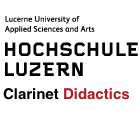Staccato (English): Unterschied zwischen den Versionen
Keine Bearbeitungszusammenfassung |
|||
| Zeile 27: | Zeile 27: | ||
</div> | </div> | ||
=Requirements for a well-responsive staccato= | =Requirements for a well-responsive staccato= | ||
==Embouchure and | ==Embouchure and Airflow== | ||
In order for staccato passages to sound as good as legato passages ([[Frédéric Rapin#L'articulation ne doit pas changer le son|Frédéric Rapin]]), the interviewees mention the following indispensable requirements: | In order for staccato passages to sound as good as legato passages ([[Frédéric Rapin#L'articulation ne doit pas changer le son|Frédéric Rapin]]), the interviewees mention the following indispensable requirements: | ||
*The [[ | *The [[Embouchure]] remains as stable in staccato as in a sustained note or a legato passage. | ||
*The basis of staccato is continuous [[Breathing | *The basis of staccato is continuous [[Breathing#Breath control|Airflow]] and [[Breathing technique#Breath support|Breath Support]], independent of the tongue movements. Fast staccati succeed better with agile air control (see learning video by [https://www.youtube.com/watch?v=paQ10Vd_gwM&t=76s Jean-François Philipp]). | ||
[[Kategorie:Fundamentals, English]] | |||
==Simultaneous control over three functions of the tongue== | ==Simultaneous control over three functions of the tongue== | ||
Version vom 1. Mai 2021, 21:41 Uhr
The skills of staccato are largely identical to those described in the chapter articulation. On this page, fast staccato and double-tongue are discussed in more detail.
Contributions of the interviewees
- Michel Arrignon
- François Benda 1, 2
- Paolo Beltramini
- James Campbell
- Eli Eban
- Steve Hartman
- Sylvie Hue
- Gerald Kraxberger
- Seunghee Lee
- Harri Mäki
- Heinrich Mätzener 1, 2
- Ernesto Molinari
- Pascal Moraguès
- John Moses 1, 2
- Robert Pickup
- Thomas Piercy
- Frédéric Rapin
- Milan Rericha
- Ernst Schlader
- David Shifrin 1, 2
- Michel Westphal 1, 2, 3
Requirements for a well-responsive staccato
Embouchure and Airflow
In order for staccato passages to sound as good as legato passages (Frédéric Rapin), the interviewees mention the following indispensable requirements:
- The Embouchure remains as stable in staccato as in a sustained note or a legato passage.
- The basis of staccato is continuous Airflow and Breath Support, independent of the tongue movements. Fast staccati succeed better with agile air control (see learning video by Jean-François Philipp).
Simultaneous control over three functions of the tongue
Italian "staccare" in a musical context means "to separate" individual notes by (short) pauses in articulation.
The tongue not only separates individual notes, it also performs important tone-forming functions after the articulation pause.
- The tip of the tongue articulates at the reed, it interrupts the vibration of the reed and releases it again. Furthermore, the position of the tip of the tongue influences intonation and timbre.
- The middle area of the tongue is involved in vowel shaping, thereby influencing intonation and timbre, and regulating air velocity. Faster airflow is especially important for response in upper registers.
- The posterior region of the tongue and the soft palate shape the pharynx as a resonance chamber. Sound fullness is optimized when the intrinsic resonances in the oral cavity match the resonances in the instrument (cf.Jonston 1999[1]).
If these three functions of the tongue can be performed simultaneously and independently, a staccato with a sound quality equal to legato can be achieved. When articulating (1), therefore, only the tip of the tongue should move. The other areas (2 and 3) of the tongue perform their specific functions independently. The interview partners agree on the following:
- The path of the tongue between the blade and the rest position should be as small as possible.
- After the tongue is pulled back, i.e., after the reed vibration is released, the tongue remains as close as possible to the place where it touched the reed (John Moses, Thomas Piercy).
- The staccato movement of the tongue is not a
- ↑ RB Johnston, PG Clinch, GJ Troup 1999. The Role of Vocal Tract Resonance in Woodwind Instrument Playing R Johnston, Acoustics Australia 14 (3), 67-69. www.researchgate.net {19 December 2020}
